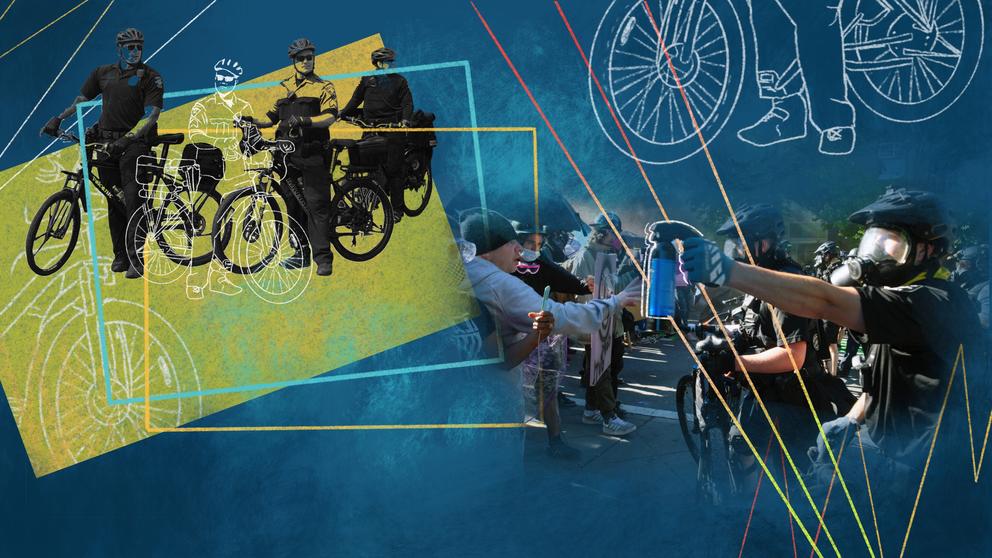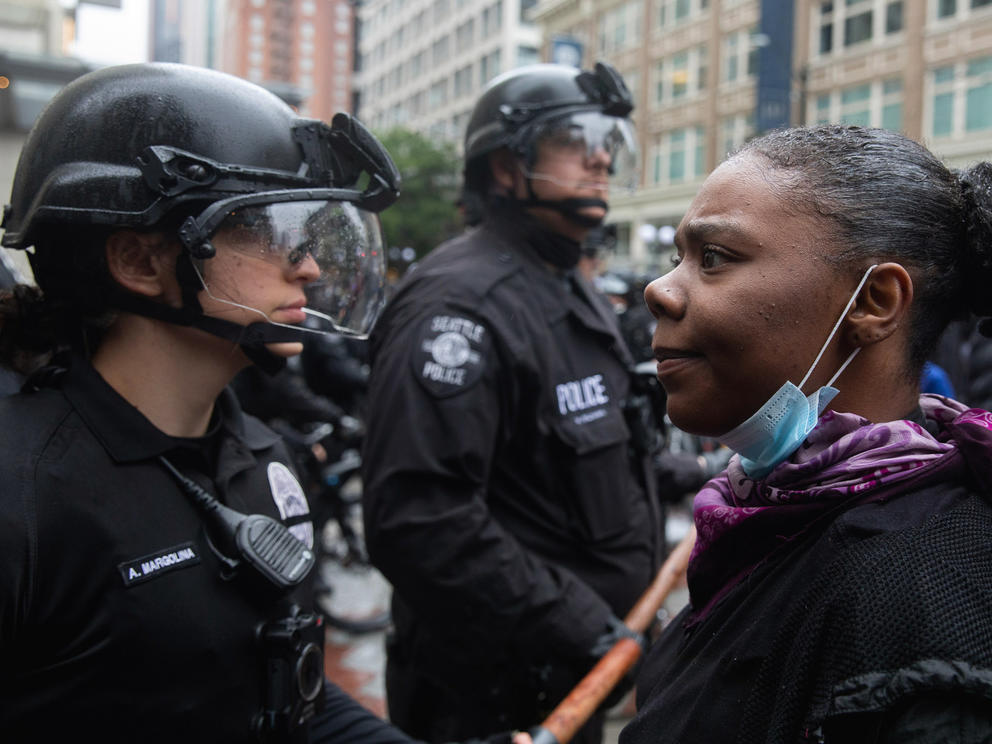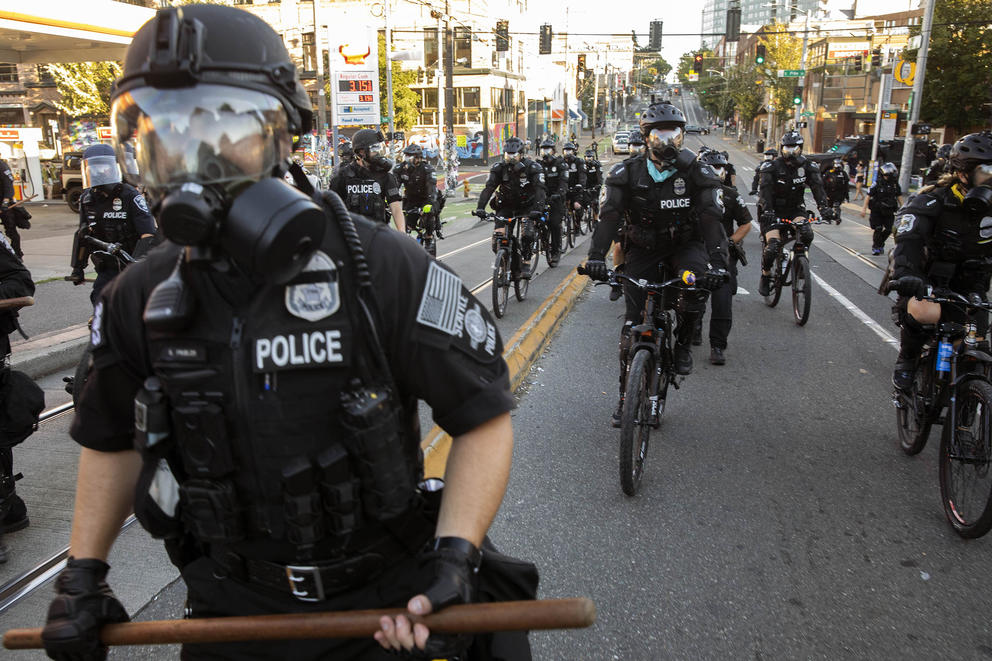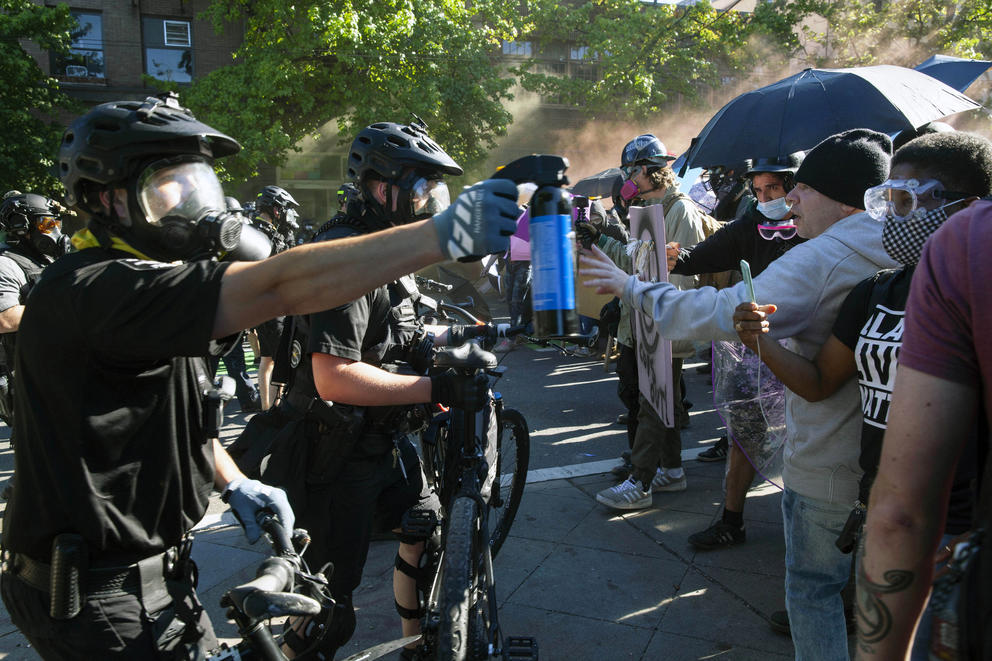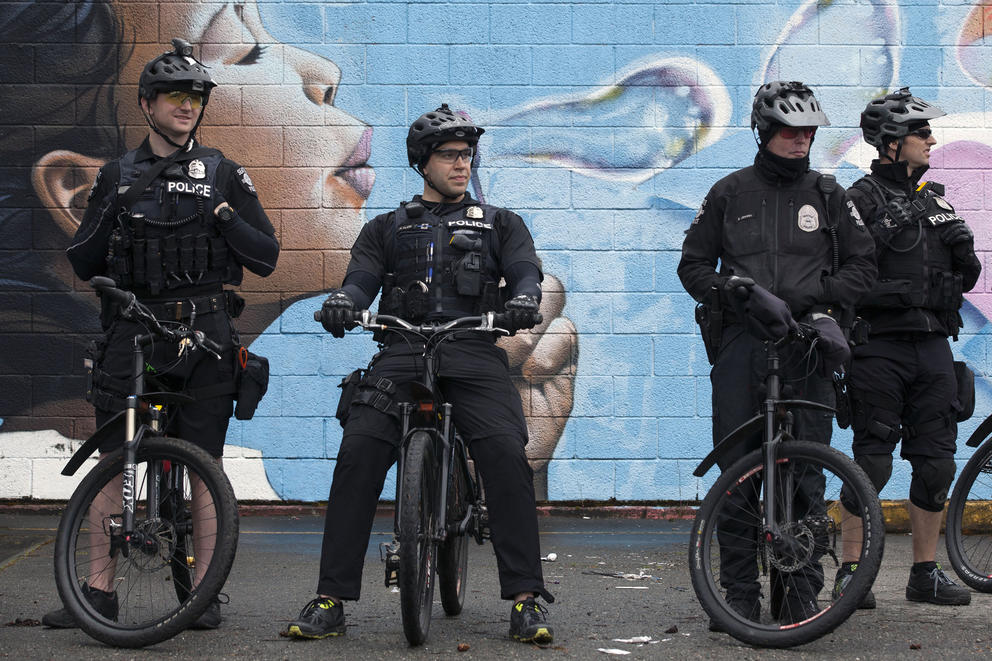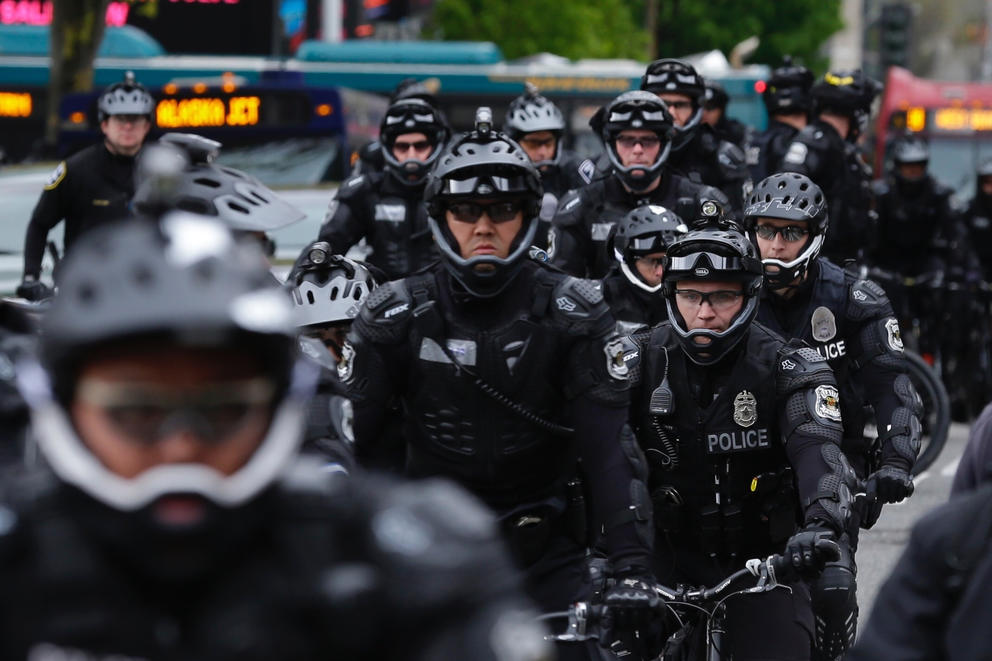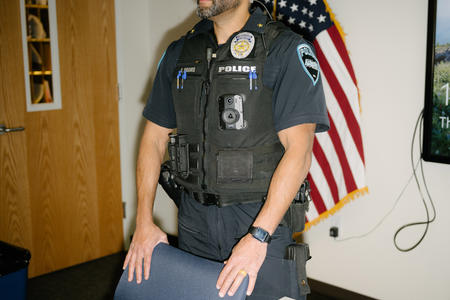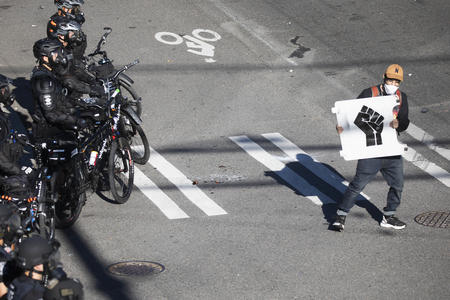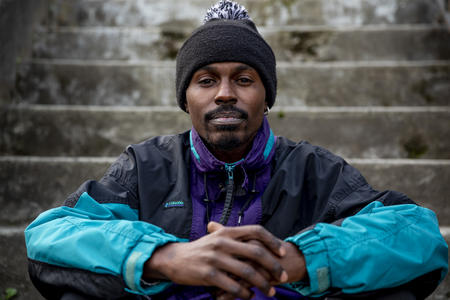Then a Seattle resident, Seth, who has asked to use a pseudonym for fear of reprisal, said they tried to stay hopeful in the moment, but it grew more difficult with every passing ping from their phone, alerting them of messages from friends with news that the police were deploying tear gas closer and closer to their location.
This story was produced in partnership with Type Investigations.
Seth and their partner were walking hand-in-hand when they saw at least a dozen police officers wearing riot gear and barrelling down the sidewalk single-file on Volcanic brand hardtail mountain bikes, shouting, “Get out of the way!”
They said the events that followed happened “very, very quickly.”
One of the police officers hit Seth’s partner with his bike, throwing them down on the concrete. Seth said they put their arms out to protect their partner and was tackled to the ground by the same police officer, who punched Seth’s head numerous times, breaking their glasses.
The police officer then zip-tied each of their hands together, lined the two up against a nearby wall with other people who had been arrested, and left them both there for 20 to 40 minutes, according to Seth’s recollection. A police vehicle arrived to take them to King County Correctional Facility.
Seth and their partner were taken to a hospital for their injuries before they were sent to jail.
“Thank God there was one nurse at county [jail] who was, like, ‘What the fuck? Both of these people likely have concussions,’” Seth recalled. “We were handcuffed while sent through an MRI. Thankfully no internal bleeding or anything.”
It was a scene familiar to many Americans as protests against police violence in the next few weeks would take place in all 50 states. In many cases, including Seth's, these protests were met with more police violence. Crosscut and Type Investigations have reviewed public records and documents about the 2020 protests that show Seth’s experience with the Seattle Police Department was far from unique. Many other protesters across the city encountered similar police violence.
The social justice demonstrations following the murder of George Floyd in May 2020 saw a massive deployment of police bike crowd-control tactics across dozens of cities and months of protracted protests. The Seattle Office of Police Accountability received more than 19,000 complaints against the Seattle Police Department from the protests beginning May 30, 2020, through the end of the year.
A demonstrator raises his hands while exclaiming "Hands up, don't shoot!" during protests across downtown Seattle, May 30, 2020. A wave of protests swept the U.S. following the death of George Floyd. The Seattle Office of Police Accountability received more than 19,000 complaints against the Seattle Police Department from the protests. (Matt M. McKnight/Crosscut)
While originally branded as a friendly community policing tool in Seattle, bike policing has spread across the country and evolved into a leading strategy for confronting crowds of demonstrators as officers use interlocked bikes to form crowd-control barriers. Seattle officers have spearheaded that transition throughout its history, from early traffic enforcement to its pioneering use against protesters in the 1999 “Battle of Seattle” to clashes against Black Lives Matter demonstrators three years ago.
In response to those protests, the Seattle Police Department also formed the Community Response Group in October 2020, absorbing the city’s bike unit and requiring all team members to be bike-trained — expanding the department’s ranks of deployable bike officers. Seattle’s Office of Inspector General last month released its final review report on police tactics during the 2020 protests, calling for an apology from the department and clearer guidelines on the deployment of bike-based crowd control.
Crosscut and Type Investigations have obtained records from Seattle and other departments across the country that shed new light on how police spend thousands of dollars on bikes, equipment, and training. As these tactics have taken a central role in violent confrontations between police and protesters, records show some officers have collected significant income as international consultants on bike-based crowd control.
But as bike policing has strayed from its roots in community relations and sustainability, some bike manufacturers have made millions in government contracts, while others have started backing away from working with police.
Mara Verheyden-Hilliard, an attorney and executive director of the Center for Protest Law & Litigation, said police violence and misconduct are going to occur regardless of the vehicle or weapon.
“There was some thinking that bicycle units are somehow going to be better because it seems softer,” she said. “But we have seen bicycle units act with extreme violence, attacking en masse, throwing their bikes down and charging crowds of people.”
The beginning of bike policing
Modern bike policing began in 1987 when Police Sgt. Paul Grady, a mountain biker in Seattle, noticed he found it easier to arrest people on his bike commutes off duty than he did driving around in a car on duty.
Grady told Bicycling Magazine in July 1997 that he “kept seeing parking meter looters on my off-duty rides and arresting them. So I asked my partner, ‘What if we were to ride mountain bikes on duty? Do you think they’d ever go for it?’ We pitched the idea to our sergeant. She laughed.”
But soon Grady obtained bikes donated from Raleigh Bicycles and became the first modern bike cop.
The original Seattle PD bikes had “Seattle Police” stenciled on them and a little plastic box on the back of the bike for storage. Back then, there was very little funding for these patrols, and they mainly relied on donations.
Grady told Bicycling Magazine in that interview that “mountain bikes have helped change police departments across the country from occupying forces encased in patrol cars to accessible allies. Bike patrols are helping people take back their neighborhoods."
In theory, riding bikes allows officers to better interact with citizens and develop relationships with communities compared to cars. They see and hear things they would otherwise miss. Bicycle patrols are also stealthy, quiet and quick. Bike cops can ride in places patrol cars can’t and catch people by surprise.
But in the 36 years since Grady first patrolled on a bike, police across the U.S. have embraced bikes to do something very different.
It wasn’t until the 1999 “Battle for Seattle” that bike policing took its modern form.
The five-day series of protests against the World Trade Organization and global economic inequality was one of the first uses of “black bloc” tactics in the USA, in which protesters all dress in black attire in order to inhibit surveillance efforts, and the first use of bikes as a crowd-control measure.
Starting on Nov. 30, 1999, protesters smashed windows and, in turn, Seattle police officers fired riot munitions and pumped tear gas into the crowds. The clashes caused then-Washington Gov. Gary Locke to declare a state of emergency.
Jim Ritter, a retired officer who spent 37 years with the Seattle Police Department, told Crosscut and Type Investigations he worked on the front lines of WTO from day one.
“Most of us didn’t really know what the WTO was,” Ritter recalled. “We knew there’s going to be a lot of people with a lot of different opinions. Our department needed to recruit the help of other agencies because we weren’t big enough to be handling crowds like that.”
So, with the help of the King County Sheriff’s Office, he said around 50 bike cops were deployed during the WTO.
The first day of the event ran smoothly, Ritter said, with most people protesting peacefully. But as the sun went down, he said they started to see “infusions of anarchists that were coming into town” and they created problems with what he called their “guerrilla tactics.”
“We’ve had plenty of civil unrest in Seattle, but nothing like WTO,” Ritter said. “I think we deployed more tear gas to control this violence than anybody had done since the Vietnam War.”
Police have used bikes since the 1890s, he said, but before it was only to get to and from their beats. In recent years, bike cops have routinely anchored crowd-control efforts at events or demonstrations.
Contacted with questions about the Seattle Police Department’s current bike-policing practices and applications, a spokesperson responded in an email that “it is against policy for us to talk about allocation of resources nor can we talk about tactics we use in the deployment of resources.”
A different spokesperson with Seattle PD’s public affairs office said in an email that the city’s bike police “are very effective at street level proactive work and also allow for a greater public relations role.”
“The bike officer is both the highly motivated crime fighter and yet also the department’s best community police officer,” the spokesperson said. “It is a very unique and special relationship the bike officer has with the people on the street.”
From bike cop to consultant
Jim Dyment was one of the Seattle bike cops deployed against protesters at the WTO. The city has long been a hotbed of antiwar and ecological activism, and this has given Dyment, now a 30-year law enforcement veteran, and his team plenty of chances to hone their skills. Dyment’s bike team has deployed over the years to handle crowd control for events including the WTO, Mardi Gras, the Seahawks 2014 Super Bowl victory, and numerous May Day events.
He would later establish himself nationally as an expert in this field. In 2015, Dyment founded Tiger Mountain Tactical, a private company that trains police officers around the world to use their bikes as an often-forceful means of crowd control. According to his website, his team has taught officers as far away as Dubai what they had learned and honed on the streets of Seattle.
Tiger Mountain Tactical’s website describes the company as a “team of current law enforcement officers who have the most comprehensive knowledge and experience in police bicycle team operations.” It also states that Dyment “developed the first policy and training for bicycle crowd management stemming from experiences during the 1999 World Trade Organization Conference in Seattle.”
Dyment did not respond to multiple phone and email requests for comment on this story.
Tiger Mountain Tactical claims to have worked with a large number of domestic and international agencies, including Swiss and French police agencies.
The City of Greenville, South Carolina’s Accounting Division reported a $16,500 travel and training payment to TMT in 2019 and a $7,500 payment in 2020. Dyment also claims that TMT advisers were on the ground at the 2016 RNC. It’s unclear how much Dyment makes from his side business, which appears to be registered at his home address.
Dyment described the tactics he’s developed in an article for the April 2016 issue of Law and Order. These include the “mobile fence line,” in which officers move forward as a line, holding their bikes in front of them like shields. Videos of the tactic show police shouting at protesters to “move back,” then hitting them with bikes if they do not. This tactic was noted in the Seattle Office of Inspector General’s report on SPD tactics in 2020. “Body-worn and third-party video shows officers using their bicycles in multiple ways, including using the frame or wheel to push protesters backwards or to force retreating protesters to move faster, and conducting ‘power slides’ to quickly form mobile fence lines,” the report said.
Many of the techniques used across the country in 2020 are the ones that Dyment and his team pioneered. Other training programs, like the International Police Mountain Bike Association, have adopted some of his tactics, including one known as the crossbow technique.
The IPMBA republished a Law and Order article describing how it works: “The bike squad forms a double column behind the line, far enough behind so they can get a little speed up to perform the maneuver. On command, the line makes a gap in the center and the bikes ride through this gap. The two lead riders ride straight to the goal while the remainder of the squad splits left and right, encircling them to protect them from the crowd.”
In documents obtained by Crosscut and Type Investigations, Dyment describes deploying with his team and using the “cross bow” technique the same weekend Seth and their partner were arrested in downtown Seattle.
Third-party training courses, like those offered by Dyment and the IPMBA, often supplement courses offered by various police departments through the Peace Officer Standards and Testing (POST) system.
These courses vary widely in their content. The syllabus for the Davis Police Department in California, for instance, focuses more on the basics of bike riding and maintenance, whereas the course offered by Allan Hancock College in San Luis Obispo teaches officers “skills to safely operate a bicycle in various environments, including crowd control and movement, terrain riding, maneuvering through traffic safely and health and mechanical issues related to bicycle patrol. Instruction in safe handling of firearms in tactical encounters is also part of this curriculum and will involve shooting skills.”
On the Tiger Mountain Tactical webpage, Dyment states his company is “unrivaled in its depth of current experience” and that “no other bicycle demonstration management program has been as thoroughly tested or used successfully as this one. No other demonstration management class is taught by individuals with the depth of experience from active officers that not only teach it but do it from TMT.”
Dyment’s bike force became a fixture at large demonstrations in Seattle. Dyment handled crowd control during President Obama’s 2014 visit to the Seattle area. The following year, in 2015, Dyment’s team faced pushback for their handling of May Day protests. One video from that event showed an officer riding his bike into a line of protesters and tackling a man whose back was turned.
Dyment’s company also consulted with the RNC for the 2016 convention in Cleveland, according to his website. Anticipating mass protests, the Cleveland Police Department also bought 300 bikes and sought training assistance from Seattle PD ahead of the event. Hundreds of people from all over the country gathered outside the convention center in Cleveland to protest the nomination of former president Donald Trump. Officers dressed in head-to-toe Fox body armor and full-face Bell helmets pushed protesters using their bikes.
Dyment explained his approach to Crosscut in 2015. “These demonstrations have exponential growth,” he said at the time. “We want to break that group mentality before it gets out of control.”
In 2021, Dyment co-founded Meza Dyment Stott LLC, registering the company with his Tiger Mountain Tactical email address, but the company dissolved itself half a year later. Former Seattle Deputy Inspector General Miroslava Meza and Keele University Professor Clifford Stott both used Meza’s address on the business filings. Meza previously described her job on Linkedin as a “public policy and applied mathematics professional dedicated to improve public safety and equity in policing.”
Stott co-wrote a report for Seattle’s Office of Inspector General entitled “Crowd psychology, policing and interactional dynamics: analyzing the early stages of the 2020 protests in the city of Seattle.” The report was released in May 2022. Stott was listed as a governor when Meza Dyment Stott LLC was incorporated in September 2021.
In an email to Type Investigations and Crosscut, Stott — who lives in the United Kingdom — clarified that he “advise[s] police forces and government internationally on reforms to promote dialogue and de-escalation capability.”
Asked about the company, Stott wrote that “in the process of my work with the OIG it was apparent that there was a need to translate my research into the US context. Through consultation with Meza and Dyment we decided to consider combining our expertise to facilitate the provision of expertise outside of Washington State. As a first step toward achieving this we established a holding company, Meza Dyment & Stott LLC.”
Although the collaboration was approved through the City of Seattle ethics board, according to Stott, “through further consultation we decided that it was not in our combined interests to develop the company and it was dissolved shortly after its formation. No trading through or activity within the company occurred.”
Meza said in an email that “around August of 2021” she was approached by Stott and Dyment to join them in their business venture. The trio had plans to provide police consulting services to cities throughout the U.S., “excluding Seattle,” Meza said.
“During this early consideration stage an LLC was created, but no further actions were taken,” she added. “After a period of consideration, we decided that we would not pursue that endeavor, there were no potential clients and there was no work done.”
Bike policing in 2020
On May 25, 2020, George Floyd was murdered by Minneapolis police officer Derek Chauvin while three other cops watched and failed to intervene. Videos of Floyd’s murder quickly sparked protests in the city and then around the country and the world.
Dyment and his team were called in while off duty beginning on May 29. According to The Seattle Times, “Beginning that first weekend, police often retaliated against the crowds with every less-lethal weapon at their disposal, including tear gas.” Dyment refers to the WTO protests several times in his use-of-force report. At one point he reflected that the 2020 protests “had grown proportionally larger than any other event I have been part of and was at the level of the 1999 WTO, however this was far more violent.” That weekend they used tear gas, pepper spray, flashbangs, and other munitions as tension and fear filled the streets along with billowing clouds of the chemical irritant.
During the first week of the uprising, Dyment was frequently on the streets with the Seattle bike police, and his use-of-force report notes that protesters quickly picked up on the mobility that bicycles offered and formed their own bike squads.
Dyment noted in his use-of-force report on June 6, 2020, that “these were individuals on bicycles who appeared to block streets and mobilize for area intelligence somewhat similar to our bicycle units. These groups reported information about police movements and resources back to someone. This was a very coordinated effort to force a confrontation with the police and did not appear to be one that had the intent of peacefully expressing themselves. This type of coordination, in my training and experience, makes traditional crowd control measures much more difficult when dispersal is necessary.”
As protests across the country continued, at least one other department, Virginia Beach PD, reached out to ask Dyment for help and tactical advice.
The Seattle Office of Inspector General’s report on the protests that summer mentions bikes or bicycles over 60 times, and notes dozens of incidents of police violence using bikes and one bizarre instance in which “Bicycle officers rode into the crowd from behind the SPOG [Seattle Police Officers Guild] headquarters as the song, “Save a Horse; Ride a Cowboy” played from the building’s external speakers.”
These incidents were not reportable according to use-of-force reporting guidelines at the time. One incident, however, was well documented thanks to a national outcry over a video of a Seattle PD officer that appears to show him running over a protester’s head with his bike.
On the night of Sept. 23, 2020, following months of nightly demonstrations, Seattle officer Eric Walter was recorded pushing his bike over the head of a protester lying in the street. Initially, he was placed on leave following widespread condemnation of the incident.
According to a use-of-force investigation report obtained through a public records request by Type Investigations and Crosscut, around midnight, Walter and his team of bike cops enforced a dispersal order against a group of racial justice protesters near the city’s East Precinct.
He recounted the events from that night in an interview conducted by the Seattle Police Force Investigation Team: “I see dude lay on the ground. I’m like okay, made, made a mental note, I’ve got officers to my, both sides, I’ve got to stay on-line, I’m going to step over this guy. If he wants to lay in front of me, fine, I’m going to step over him, I’m going to move my bike around him, no big deal, not a problem. He’s just an obstacle in the street, I’ll just get over him and keep going.”
Videos of the incident show a different story. Walter runs over Camillo Massagli's head, causing his helmet to fall off and Massagli to instinctively cover his head. Massagli was then arrested by officers using a cross face hold. Massagli is quoted in the use-of-force report as saying that Walter “specifically tried to run over my head,” and that the subsequent cross face hold “tweaked my neck and it hurt a lot.”
While Massagli declined to press charges against Walter, SPD later suspended the officer for a week without pay.
Who makes money?
Bike companies, along with training companies like Dyment’s, make significant money from police department contracts. Even as public outcry over these contracts grew in 2020, some brands continued to maintain ties with the police.
Seattle Police officers use Volcanic Bikes. Based in Washington until 2022, Volcanic recently moved to Nebraska after co-owner and former bike patrol officer Nathan Keenan bought into the company. Volcanic supplies “just under 1,000” agencies across the country, according to Keenan, who said they are still a relatively small player in the patrol-bike industry.
Volcanic markets their bikes as “patrol bikes” and sells a frame of their own design, which founder Eric Kackley created when he was working at a shop in Olympia in the early 2000s and noticed local bike patrol officers were constantly having issues with their patrol bikes. In 2005, Volcanic gained their first contract with the Seattle Police Department. Eighteen years later, Volcanic sold a fully equipped police model for $2,459, which uses the same frame bundled with police bags made by Topeak and blue and red lights made by Nite Rider.
Keenan also said Volcanic, which still retains a machine shop in Washington, often does custom orders, which include department logos, colors, or upgrades on certain parts of the bike, such as the fork or wheels. Volcanic does offer a non-police livery bike, and also makes bikes for other emergency services, but the majority of its line is catered toward law enforcement.
Seattle PD, Volcanic’s first and longest client, has several different custom specified variations of Volcanic’s APB bike in its garage. “In the past Seattle wanted Fox [suspension forks],” Keenan said, “and then now they’re back to Rock Shox.”
Bigger bike brands, for whom police bikes represent only a small percentage of sales, faced more pushback in 2020. Instagram accounts like “Defund Bike Police” and “High Impact Cycling Memes” gained traction in the summer of 2020 amid criticisms of Trek, one of the largest bike brands in the USA, for its policy of talking about racial justice while supplying police and its apparent support of one rider’s racist statements online.
Athletes affiliated with Trek also spoke out against the brand’s ongoing support of police during 2020, and some of them left the brand.
Trek’s bikes appeared in the hands of police officers throughout the country in 2020. Miami police officers with the department’s “Bicycle Response Team” drew criticism for their violent use of Trek bikes. Austin bike cops maced protesters in the face at close range. Philadelphia police on Trek bikes beat protesters over the head. In Chicago and New York, officers snatched protesters’ bikes.
In an email to The Verge in 2020, Trek claimed “in terms of police departments, Trek does not have contracts with them. The bikes are sold through local bike shops to local police departments based on the department's needs.”
Later, Trek clarified to Crosscut and Type Investigations that they did have a direct contract with Chicago. But public records reveal that Trek corporate and its directly owned stores — as opposed to independently owned local stores — have benefitted from over $1 million in contracts and purchase orders with police departments in Ohio and Texas and Illinois as well as federal law enforcement agencies in Washington, D.C. These stores are owned by Trek and sell mostly products from the Trek family of brands, but independent bike shops buy bikes and parts from Trek and sell them alongside other brands.
Trek also sells bikes, branded with their logos and the word “Police,” on their website and through police suppliers like Safeware. Some independently owned bike shops, including in Florida and Pennsylvania, have had contracts with local police to provide Trek bicycles.
These contracts allow Trek corporate to sell to police all over the country while fulfilling the requirement in most police requests for proposals or “RFPs” that local provisioning be used.
Some of these RFPs, including one put out by the U.S. Secret Service in June 2020, ask for Trek bikes by name and will not accept other brands. Trek’s relationship with the Secret Service goes back over 25 years, when the company offered eight bikes to the agents at no cost.
Fuji, another large bike brand with a market extending well beyond law enforcement, suspended sales to police in 2020. The company said in a statement published on Twitter: “In the last week, we have seen our bicycles used in violent tactics that we did not intend or design them to be used for.”
“In an effort to work towards real change, Bike Co. the North America distributor of Fuji Bikes is suspending the sale of police bikes,” the statement concluded. The brand has not resumed sales of police bikes since making the statement.
Despite public pushback since 2020, some cities across the country have invested even more money in police bikes. From upstate New York to Atlanta and Fresno, bike units in some areas have either grown or started for the first time in recent years.
Keenan says that despite the reduction in competition, Volcanic has not seen a surge in demand. He says there has been a steady growth in demand since the brand’s founding in 2005. Keenan believes agencies are buying bikes in greater numbers for their perceived benefits in community interaction, not crowd control.
“I personally think it’s a great opportunity for each department to reach individuals that they would not normally,” he said. “And I really hope that the trend continues to push towards bridging that gap between the community and law enforcement.”
Bike cops keep rolling
Dyment was part of the panel that reviewed the Seattle Police Department’s response to the city’s protests in 2020. That panel concluded last month that the department should improve communication with media; evaluate police policies, including bicycle tactics; as well as “acknowledge the harm to BIPOC community caused by Seattle Police actions over time and issue a public apology for the actions of Seattle Police during the 2020 protests."
The committee’s reports mentioned bike policing dozens of times, and noted that the use of bicycles to push protesters was not a reportable use of force under guidelines in place at the time.
The report also found that “many examples of bicycle tactics reviewed by the Panel were problematic to panelists, who questioned their utility in managing a largely peaceful crowd complying with police directions.” The OPA suggested that Seattle PD “should select a group of officers and supervisors with expertise in bike tactics and crowd control to evaluate these tactics and determine the proper applicability of bike pushes and SPD should clearly state its expectations on how bike tactics and attendant force will be documented and investigated.”
As of May 2023, Dyment is a lieutenant with the Seattle Police Department’s Wellness Services Unit, which he helped form in 2019.
The events of May 30, 2020, are still fresh in Seth’s mind. But three years later it is a lot harder to be hopeful about the future. Police reports did not mention Seth’s injuries or injuries to any police officers, but Seth’s booking photo shows purple bruises on their forehead.
Seth and their partner were ultimately jailed for nearly three days, and Seth, who has no prior criminal history, was arrested on charges of assaulting a police officer. In Washington this is considered a class C felony, punishable by a maximum sentence of five years in prison, a maximum fine of $10,000, or both.
According to a police report, Seth “shoved” a police officer “violently with both of his hands, trying to push him off of his bike” and “raised his clenched fists towards his chest while facing” the officer.
The police accused Seth’s partner of using their arm and shoulder to run into them while they were on their bike.
As of publication, no charges have been filed against Seth or their partner. Seth no longer lives in Seattle, partly to avoid reminders of their experiences with the city’s police.
“A big part of leaving was the protests in 2020 and dealing with PTSD from that, and just not being able to go downtown or take the train through downtown without some of those symptoms flaring up,” they said.
After 2020, Seth said they haven’t been to another protest and don’t plan on going back to one.
“I'm still involving myself as much as I can in terms of local organizing,” they said. “[But] maybe re-traumatizing myself by going out into the streets just to get beaten up again by cops might not be the most effective form of practice.”
Listen to reporters James Stout and Jordan Gass-Pooré discuss this story on the Crosscut Reports podcast:

